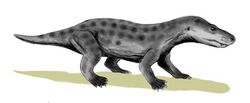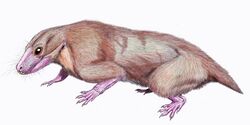Biology:Ericiolacerta
- REDIRECT
early Triassic
| Ericiolacerta | |
|---|---|

| |
| Ericiolacerta parva | |
| Scientific classification | |
| Domain: | Eukaryota |
| Kingdom: | Animalia |
| Phylum: | Chordata |
| Clade: | Synapsida |
| Clade: | Therapsida |
| Clade: | †Therocephalia |
| Family: | †Ericiolacertidae |
| Genus: | †Ericiolacerta Watson, 1931 |
| Species: | †E. parva
|
| Binomial name | |
| †Ericiolacerta parva Watson, 1931
| |

Ericiolacerta is an extinct genus of small therocephalian therapsids from the early Triassic of South Africa and Antarctica.
Characteristics
It was around 20 centimetres (7.9 in) in length, with long limbs and relatively small teeth. It probably ate insects and other small invertebrates. In the early Triassic, African flora was rich. The vegetation was used as shelter and food for numerous insects Ericiolacerta fed on.[1]
The therocephalians – therapsids with mammal-like heads – were abundant in Permian times, but only a few made it into the Triassic. Ericiolacerta was one of those. It is possible that they gave rise to the cynodonts, the only therapsid group to survive into post-Triassic times. Cynodonts gave rise to mammals.
Little holes in the snout area of the skull suggest that perhaps the snout had developed sense organs, like whiskers. A palate in the roof of the mouth separated the breathing passage from the eating area. This suggests an efficient eating mechanism that may indicate a warm-blooded lifestyle.
Ericiolacerta, meaning "Eric's little lizard", was named in 1931.
See also
- List of therapsids
References
- ↑ The Complete Guide to Dinosaurs and Prehistoric Reptiles, Chris McNab and prof. Michael Benton, Marshall Editions, London 2006.
Wikidata ☰ Q1186935 entry

